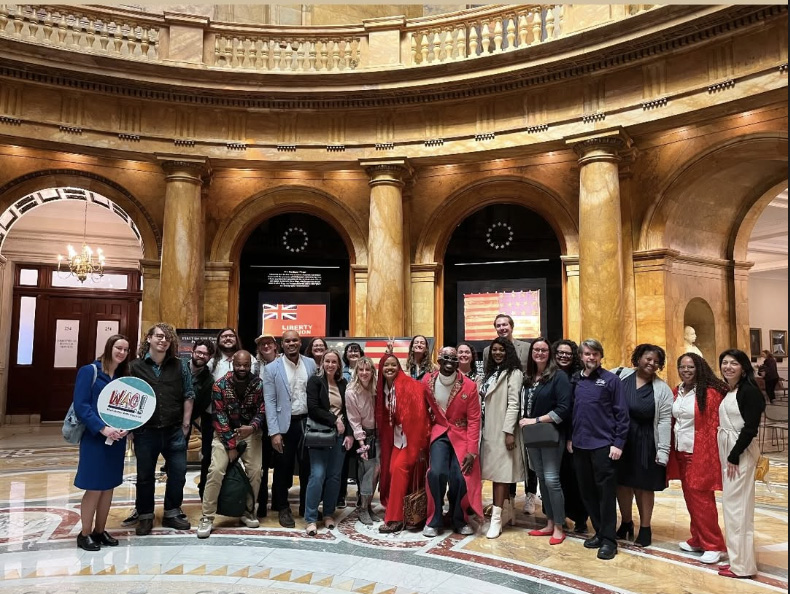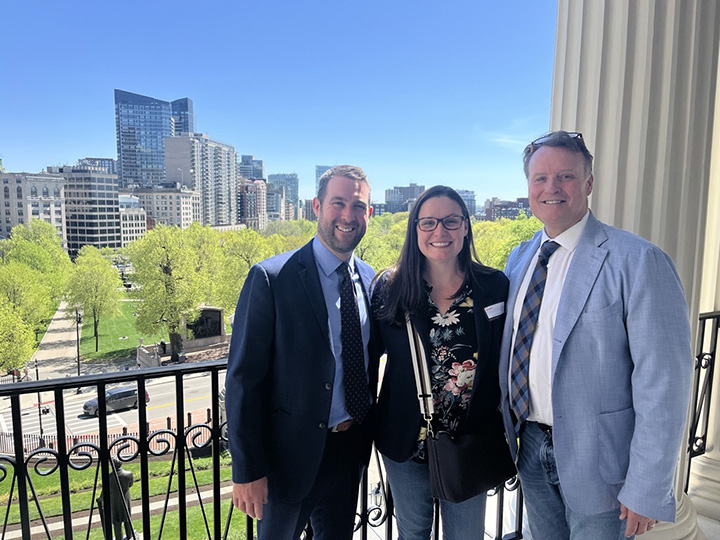By Grace Elton, New England Botanic Garden CEO
May 2025

Leaders of Central Massachusetts arts and culture organizations gather at the State House for Creative Sector Advocacy Day (Photo by Worcester Cultural Coalition)
At the recent Creative Sector Advocacy Day, held April 30 at the Massachusetts State House, hundreds gathered in an energetic, denim-clad show of support for the arts at a critical moment. Abrupt cuts to legally granted federal funding continue to hit arts and culture organizations across the country. Many, including the organization I represent as CEO, New England Botanic Garden, have received emails and letters from federal agencies terminating essential grants with no explanation apart from the words, “Your work no longer aligns with the priorities of the administration.” Losses have sent organizations reeling, with some expressing very real concerns about their futures.
Here in Massachusetts, state lawmakers are currently debating the FY26 budget, which is why creative sector organizations have been hard at work advocating for increased funding to arts and culture.
What stake does a public garden really have in this conversation? Horticulture is both an art and a science, and public gardens provide tremendous cultural and community benefits by thriving at the intersection of both. Blame the showiness of flowers if the full impact of public gardens is often misunderstood.
Public gardens are living museums. Instead of priceless art or historic artifacts, public gardens care for irreplaceable collections of plants. At first glance, it’s easy to see only beautiful flowers, but behind each plant is a story and a data point—what it is, where it came from, what scientific significance it holds. Using the knowledge held in living plant collections, thousands of botanic gardens across the globe are protecting biodiversity, conserving rare plants, and contributing to research. We are also providing ecological education to the community, creating access to green space, and connecting people to the natural world through arts and culture programs.
As is true for many cultural institutions, including public gardens, funding allocated by state and federal governments plays a vital role in constructing budgets. General admissions and ticket sales from events generate income. Endowments might also support a portion of operations, as does philanthropy. But it’s unrestricted operating support grants from state-funded agencies like Mass Cultural Council and others that allow cultural organizations to grow their missions and respond to community needs.
One of the best parts of Creative Sector Advocacy Day was hearing both Governor Healey and Lt. Governor Driscoll say that Massachusetts residents are telling them that the arts are important to them. This is exciting and encouraging. It also just makes sense.

Representative Dan Donahue, CEO Grace Elton, and Senator Michael Moore (L to R) at the State House during Creative Sector Advocacy Day
The arts touch so many lives directly and indirectly. In a national analysis, Massachusetts ranked as the third most arts-vibrant state in the country. According to the Mass Cultural Council’s 2024 Cultural Asset Inventory, a project that paints a numerical picture of the state’s cultural landscape, 3% of the Massachusetts workforce earns their livelihood through the arts, and more than 15,000 cultural organizations and programs exist in our communities providing meaningful and enriching experiences for people of all ages. The sector is also driving tourism, and it’s delivering $29.7 billion in value to the economy, according to data from the U.S. Bureau of Economic Analysis and the National Endowment for the Arts.
Arts and culture organizations give more to our communities than they take, and that’s why they need support. But just because we’ve delivered a message, signed a petition, or attended a rally, doesn’t mean we should stop saying from every platform that we have: arts and culture are essential. Our lawmakers need to hear more from us in the days and weeks ahead.
The creative sector, inclusive of public gardens, helps us to see the world around us in a different way. And that’s why this work is vital. In such divisive times, opportunities that allow us to relate to one another better couldn’t be more important.
